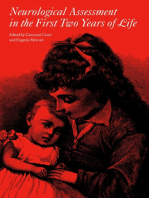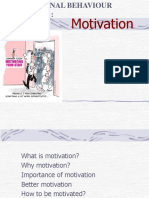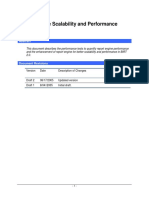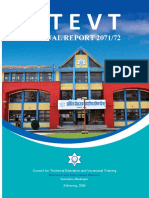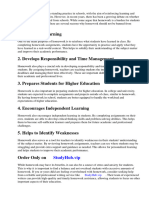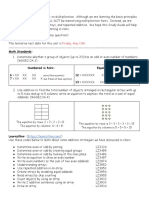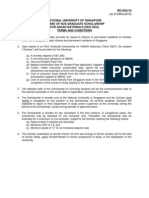Autism Spectrum Disorder and Behavioral Interventi
Uploaded by
Wesley RiannAutism Spectrum Disorder and Behavioral Interventi
Uploaded by
Wesley RiannSee discussions, stats, and author profiles for this publication at: https://www.researchgate.
net/publication/282513948
Autism Spectrum Disorder and Behavioral Intervention : An Updated Review
Article in Journal of korean Academy of Child and Adolescent Psychiatry · June 2015
DOI: 10.5765/jkacap.2015.26.2.86
CITATIONS READS
0 332
9 authors, including:
Subin Park Youngsun Lee
Georgia Institute of Technology Inha University
95 PUBLICATIONS 1,817 CITATIONS 44 PUBLICATIONS 456 CITATIONS
SEE PROFILE SEE PROFILE
Bungnyun Kim
Seoul National University
405 PUBLICATIONS 5,929 CITATIONS
SEE PROFILE
Some of the authors of this publication are also working on these related projects:
Transition & Technology (Rocket Reader + WF) View project
A Study about Effects of Osmotic-Controlled Release Oral Delivery System Methylphenidate on Regional Cerebral Blood Flow in Korean Children with Attention-Deficit
Hyperactivity Disorder View project
All content following this page was uploaded by Bungnyun Kim on 28 December 2017.
The user has requested enhancement of the downloaded file.
REVIEW ARTICLE pISSN 1225-729X / eISSN 2233-9183
J Korean Acad Child Adolesc Psychiatry 2015;26(2):86-93 http://dx.doi.org/10.5765/jkacap.2015.26.2.86
Autism Spectrum Disorder and Behavioral Intervention :
An Updated Review
Hae-Ah Park1), Johanna Inhyang Kim, M.D.2), Yeni Kim, M.D., Ph.D.3),
Subin Park, M.D., Ph.D.4), Younghui Yang, M.D.4), Youngsun Lee, Ph.D.5),
Hyojung Lee, Ph.D.6), Soo Yeon Kim, M.D.2), and Bung-Nyun Kim, M.D., Ph.D.7)
1)
College of Medicine, Seoul National University, Seoul, Korea
2)
Division of Child and Adolescent Psychiatry, Department of Psychiatry, Seoul National University Hospital, Seoul, Korea
3)
Department of Adolescent Psychiatry, Seoul National Hospital, Seoul, Korea
4)
Department of Psychiatry, Seoul National Hospital, Seoul, Korea
5)
Department of Education, Inha University, Incheon, Korea
6)
Department of Education, Dongguk University, Seoul, Korea
7)
Department of Psychiatry and Behavioral Science, Seoul National University College of Medicine, Seoul, Korea
Autism spectrum disorder (ASD) is a neurodevelopmental disorder marked by impaired social communication and repetitive,
restricted behaviors and activities. The prevalence of ASD has been increasing for the past 2 decades, but evidence-based thera-
peutic approaches are lacking for patients with ASD. To date, there is no cure for the core symptoms of ASD, and the existing
treatments focus on improving the patient’s function and adaptation by using behavioral intervention methods. Behavioral inter-
ventions have been proven to show the greatest effect when applied before the age of 2 years, for at least 40–60 hours per week.
Many clinicians and ASD families are unfamiliar with the treatment methods, and consequently, may seek unproven and poten-
tially hazardous methods. The purpose of this article was to present an extensive and updated review on evidence-based ASD be-
havioral interventions that are commonly used in clinical settings.
KEY WORDS:Autism Spectrum DisorderㆍBehavioral InterventionㆍApplied Behavior AnalysisㆍIndividualized Treatment.
States, with an average male-to-female ratio of 4.3 : 1.2) Other
Introduction epidemiology studies presented controversial results, and
have been showing a trend towards an increase in incidence
According to the Diagnostic and Statistical Manual of Men- rates. Prevalence estimates range from 0.07% to 1.8%, and
tal Disorders, 5th edition,1) autism spectrum disorder (ASD) continue to rise, but it is still unclear to what extent this is a
is defined as a neurodevelopmental disorder marked by per- true increase or a product of expanded diagnostic criteria.3)
sistent deficits in social communication and social interac- The trend of increase in prevalence of ASD in Korea is simi-
tion across multiple contexts, and restricted, repetitive pat- lar to that seen in the U.S. A previous study estimated an ASD
terns of behavior, interests, or activities. The severity of ASD prevalence of 2.6% with a male-to-female ratio of 2.5 : 1 in
is divided into 3 levels according to the degree of social com- the general population. Despite the increase in prevalence,
munication impairment, and restricted, repetitive patterns of there remains a high proportion of undiagnosed and untreat-
behavior. ed children population with autism in Korea ; approximately
According to a study in 2003, there were approximately 2/3 of children with ASD remain undetected and unnoticed.4)
60 out of 10,000 children diagnosed with ASD in the United The main reason is the social stigma associated with autism
diagnosis, as many families are unwilling to test their chil-
Date received : May 28, 2015
Date of revision : June 10, 2015
dren for autism and be labeled as “genetically inferior.”
Date accepted : June 11, 2015 Individualized treatment is recommended due to the vari-
Address for correspondence : Bung-Nyun Kim, M.D., Ph.D., Department of
Psychiatry and Behavioral Science, Seoul National University College of
ety of symptoms and diverse functioning levels of each pa-
Medicine, 101 Daehak-ro, Jongno-gu, Seoul 110-744, Korea tient. Currently, there is no medication available to cure the
Tel : +82.2-2072-3647, Fax : +82.2-747-5774
E-mail : [email protected]
core symptoms of autism. Medications are usually prescribed
This study was supported by a grant of the Korean Social Service R&D Proj- to treat comorbid conditions such as impulsivity, short atten-
ect, Ministry of Health & Welfare, Republic of Korea (HI14C1098).
tion span, sleep behaviors, anxious mood, agitation, and self-
- 86 -
Hae-Ah Park, Johanna Inhyang Kim, Yeni Kim, Subin Park, Younghui Yang, Youngsun Lee, Hyojung Lee, Soo Yeon Kim, Bung-Nyun Kim
injurious behaviors.1,3) perts design a carefully reviewed regimen. Necessary skills
As a primary treatment choice, educational and behavior- that need to be learned are broken down into smaller compo-
al interventions play a major role in promoting social, adap- nents for efficient teaching sessions. Each component of skills
tive, and behavioral functions in children with ASD, and ad- is taught in a successive manner. After mastering one skill,
dress issues including communication, social skills, daily- the child receives training for more difficult tasks. The final
living skills, play and leisure skills, academic achievement, goal of the training is to reach the maximum capacity of the
and maladaptive behaviors.5) Although many different tech- child and independence in daily life.10) Training sessions are
niques are available, only some of these approaches are con- carefully monitored for early detection of inappropriate teach-
sidered ‘evidence-based’. To our knowledge, few Korean ing methods and for assessment of progress.
guidelines give a comprehensive insight into the evidence- In order to achieve the stated goals that are set at the be-
based behavioral treatments. The purpose of this article is to ginning of education, ABA based interventions focus on al-
present an updated review on the behavior interventions of tering the environmental variables through antecedent-be-
ASD, and help develop a more thorough understanding of the havior-consequence (ABC) contingencies. Antecedent cues
non-pharmacological treatments for problem behaviors, and behaviors, which is prompted by the behavior therapist or
ultimately help clinicians and ASD families to get a better the parent. Consequence is a reinforcer that can increase and
perspective on the selection of appropriate treatments.2-4) sustain the desired behaviors and remove maladaptive ones.
To help children learn through ABC contingencies, it is
Applied Behavior Analysis important to follow certain rules that make behavior inter-
ventions effective. Behavior interventions should be applied
Applied behavior analysis (ABA) is considered the opti- to children as early as possible and address the main prob-
mal behavioral intervention, well supported by research. lems of autism in a predictable setting. These personally
ABA is an intervention based on the principles of operant tailored therapies are more effective in a low teacher-to-stu-
conditioning and is applied in a systematic and measurable dent ratio environment, and when the family is involved. Th-
manner to increase, reduced, maintain, or generalize target erefore, parents need to undergo extensive training as well.10)
behaviors. ABA reinforces the positive behaviors and dis- In addition, autistic children should be able to apply the
courages maladaptive behaviors. Because each autistic child learned lessons to more generalized situations. Otherwise,
exhibits different behavior problems, he receives individu- the child will not be able to utilize the learned skills in an un-
alized therapies for different target behaviors. Numerous expected environment and will exhibit maladaptive and re-
studies during the past 5 decades have shown that ABA suc- petitive behaviors again. Learning appropriate behaviors as
cessfully yields substantial improvements in patients with well as making those behaviors sustainable over time is cru-
ASD in terms of IQ, language, academic performance, and cial. Because the learned skills may be lost over time, it is im-
adaptive behavior compared with control ASD groups.5) portant to assess the child’s behavior patterns repeatedly.11)
Lovaas6) stated that 47% of the studied ASD children who
received intensive early ABA had outcomes similar to nor- Discrete Trial Training
mally developing peers, and recent studies concluded that
ABA is superior to other intervention strategies.7) The success of ABA has led to the emergence of many dif-
Functional behavior analysis or functional assessment is ferent forms of training. One of the earliest forms of behavior
an empirically based method of gathering information that interventions developed based on ABA is the discrete trial
can be used to maximize the effectiveness of behavioral in- training (DTT), also referred to as early intensive behavioral
terventions. It starts with a clear description of the target be- intervention if delivered before the age of 5 years, and is con-
havior, identifying the antecedents, consequences, and other ducted in classroom-like settings. DTT is now the most wide-
environmental factors influencing the behavior; the next step ly recognized form of ABA, where the teacher sits down with
is to hypothesize the motivating function of the behavior, and the child with ASD and follows well-scripted tasks. DTT
then collecting observational data to test the hypothesis.8) refers to a technique based on breaking down specific skills
Before a treatment regimen is implemented, the child’s into small discrete components, and then teaching them in a
developmental and skill levels in communication, play, self- graduated fashion, with reinforcement of correct responses
care, and academics are tested.9) After a thorough assessment and negative feedback to incorrect responses.
by observing the child’s interaction with the environment, ex- DTT has four instructional components: 1) presentation of
- 87 -
Autism Spectrum Disorder and Behavioral Intervention
a discriminative stimulus, 2) occurrence or approximation Normally developing children are excessively responsive
of the targeted response, 3) delivery of a reinforcing consequ- to environmental stimuli requiring curbing of hyperactivity ;
ence, and 4) a specified intertribal interval.11) The first part however, autistic children are only responsive to certain stim-
( presentation of a discriminative stimulus) can be divided uli. Moreover, children usually learn to behave appropriately
into two different steps, cue and prompt, and some research- in new complex situations through interactions with the natu-
ers consider DTT as having five components–cue, prompt, ral surroundings ;20) therefore, children with ASD need to ex-
response, consequence, and intertribal interval. Cue is pre- plore them in a more proactive manner. This type of a more
senting a stimulus and prompt is assisting the child to answer active form of learning can happen through PRT, and its ma-
the question correctly. Prompt usually accompanies or im- jor goal is to develop motivation. In order to keep the chil-
mediately follows cue.12) dren with ASD motivated to learn, their choice of preferred
DTT is one of the essential training techniques in helping objects are incorporated into the learning sessions. Although
children with ASD with three aspects that may increase le- the clinician follows the child’s lead, the environment remains
arning and motivation. First, each discrete trial only lasts ab- structured so that the desired target behaviors are incorpo-
out 2 to 5 minutes for better concentration and more learn- rated into the activities, while maintaining the child’s atten-
ing opportunities in a given time. Second, teachers work one- tion and decreasing the likelihood that the child will avoid
on-one with the child, and the child receives tailored learning the interactions and engage in disruptive behaviors.21)
sessions that can be altered depending on the child’s perfor- As they become more eager to learn, children with ASD
mance. Third, DTT has a definite model, so it clarifies the should be able to respond to various stimuli. The interven-
teaching situation for the child.13) tions that teach these children to respond to multiple cues in
There are certain limitations to DTT. First, it is a slow the environment have been shown to enhance the attention
process that takes thousands of trials to master the necessary to social cues and increase learning and generalization.18)
skills. Second, since it is conducted in a very structured set- Self-management is another important aspect of PRT.
ting with well-written scripts, it is difficult for a child to gen- Teaching self-management procedures involve teaching in-
eralize the learned skills, and he may even become cue- and dividuals to discriminate between appropriate and inappro-
reward-dependent.14) Third, it also goes against the basic ear- priate behaviors, then to actively record the correct responses.
ly childhood teaching principle, wherein children should in- This will aid children with ASD to generalize the learned
teract with their peers to develop language and social skills.15) skills across different settings, while the self-initiation skills
Fourth, as with non-autistic children, it is not easy to moti- help them to be more engaged in learning language, social
vate children with ASD to participate in learning behavior skills, and pragmatics.22)
for a prolonged period. There arose a need for increasing the
responsiveness of these children to tasks,16) which led the Training and Education of Autistic and
scholars to focus on teaching pivotal responses for improve- Other Communication
ment in other areas collaterally.17) Handicapped Children
Pivotal Response Treatment Along with other ABA-based interventions, the training
and education of autistic and other communication handi-
To compensate for the limitations of traditional ABA tech- capped Children (TEACCH) method is commonly used, and
niques, Koegel et al.17) developed a more naturalistic ap- has a long history with well-defined features.23) The frame-
proach called the pivotal response treatment (PRT). PRT is work for TEACCH is structured learning that emphasizes
based on ABA principles, and differs from traditional meth- development of vocational, social, and living skills through
ods by being play-based and child-initiated. It targets the the use of visual prompts in the environment under the theory
“pivotal areas” rather than individual behaviors, including that children with ASD are more visually oriented and more
motivation, response to multiple cues, self-management, and deficient in auditory stimulation.23) The four major areas of
initiation of social interactions. Learning within these pivot- focus are physical organization, visual schedules, structured
al areas helps children acquire skills in fields that are not di- work system, and predictable task organization.24) TEACCH
rectly covered during teaching sessions in DTT,18) and PRT is is significant because it was designed to make the children
important because it bridges the gap between DTT in a struc- with ASD contribute to the community as a productive indi-
tured setting and incidental learning in a natural setting.19) vidual, whereas many of the previous interventions focused
- 88 -
Hae-Ah Park, Johanna Inhyang Kim, Yeni Kim, Subin Park, Younghui Yang, Youngsun Lee, Hyojung Lee, Soo Yeon Kim, Bung-Nyun Kim
more on family and social life.19) with ASD are lacking but follow the developmental sequence
There are common characteristics shared between ABA of normally developing children. It is based largely on key
and TEACCH : 1) curriculum content that emphasizes five deficits in imitation, emotion sharing, theory of mind, and
basic skill domains–ability to selectively attend to stimuli in social perception by using play, interpersonal relationships,
the environment, imitative ability including both verbal and and activities to foster symbolic thought and teach commu-
motor imitation, receptive and expressive language ability, nication.29) Interventionists create a warm and fostering en-
appropriate toy play, and social interaction skills ; 2) highly vironment to build a positive relationship between child and
supportive and structured teaching environment ; 3) predict- adults while encouraging learning.30) Teaching typically oc-
ability and routine ; 4) functional approach to problem behav- curs in the child’s natural habitat with the help of family mem-
iors ; 5) transition between preschool to kindergarten/first bers during meal time, toilet training, bathing, chores, play-
grade ; and 6) family involvement.25) time, and community outings.29)
In the TEACCH program, the skills that are taught in a Because the Denver model is one of the most commonly
structured environment can also be taught in a home envi- used developmental intervention models, and the importance
ronment to provide a generalization across the settings.24) of early intervention in autism is known, this model has been
Therefore, it is important to share the information regarding expanded from school-aged children to infant-toddlers. This
the program between therapist and parents.22,23) is called the Early Start Denver Model (ESDM). The effects
In a controlled study, a 4-month TEACCH-based home of the ESDM have been proved through a randomized con-
program along with local day treatment programs showed trolled trial, where most of the improvements came from re-
significantly more improvements in children with ASD com- ceptive and expressive language.31)
pared with a control group with only local day treatment ser-
vices.26) Developmental Individual-Difference
Relationship-Based Model
Developmental Models
Developmental individual-difference relationship-based
While ABA assesses the individual behavior of children to model (DIR) is another form of behavior intervention that fo-
determine which behavior to strengthen or weaken, the teach- cuses on the child’s developmental assessment. It integrates
ing goals of developmental models are based on the evalua- a relationship-focused intervention with floor time play.32) The
tion of developmental skills. It is based on Piaget’s develop- premise of DIR is that an adult can help a child expand his
ment theory that cognitive development is a combination of or her circles of communication by meeting the child at his/
biological maturation and adaptation to environment.27) her developmental level and building on the strengths of the
The assessment of the child includes 1) clinical observa- child. The ‘D’ in the DIR model represents developmental ca-
tions of child-caregiver interactions and child-therapist inter- pacities that emerge during the early years including shared
actions ; 2) review of the child’s developmental history ; 3) as- attention, engagement, back and forth interactions, creating
sessment of current intervention programs and responsiveness play ideas, and abstract thinking. The ‘I’ stands for the indi-
of the child to the intervention ; 4) multidisciplinary consulta- vidual differences in the sensory and motor processing capa-
tion from specialists ; and 5) biomedical evaluation.28) This bilities, and the ‘R’ means relationships and environments,
comprehensive developmental assessment of a child with ASD through which the child can develop to function fully in emo-
leads to individualized therapy that can help in different do- tional, social, and cognitive capacities.33)
mains affecting the child’s daily functioning, communica- One of the major components of the DIR model is the floor
tion, and social skills. time where the child leads the interactions with adults on
the floor. The six elements of floor time are self-regulation
Denver Model and shared attention, engagement and relating, two-way in-
tentional communication, purposeful complex problem solv-
The Denver model is one of the most studied developmen- ing communication, creating and elaborating symbols (ideas),
tal models. It views ASD as a complex disorder, affecting and building bridges between symbols (ideas). During the
children in virtually all areas of functioning, and especially self-regulation and shared attention stage, the child is led to
focuses on affect, arousal, and attention. Interventionists who engage all senses and motor capacities into play for enjoy-
employ the Denver model focus on areas, which the children able interactions. Then, the child is encouraged to feel plea-
- 89 -
Autism Spectrum Disorder and Behavioral Intervention
surable senses and learn to ‘fall in love’ in the engagement Skill-Based Developmental Training
and relating stage. The next stage involves following the
child’s lead and challenging him to communicate through ex- There are other forms of interventions for children with
changes of gestures and emotional signals about his affects. ASD that can help them become more interactive and im-
In purposeful complex problem solving communication st- prove the quality of life. The two major forms of interventions
age, the adult and child work in s back to back continuous that are widely used today are the picture exchange commu-
flow communication for 30 minutes before moving onto the nication system ( PECS) and positive behavior support
next stage of relating to sensations, gesture, and behaviors in (PBS). The PECS focuses on expressing opinions and ask-
a world of ideas, which can be shared in pretend play. In the ing questions as the name implies, while PBS emphasizes
last stage of building bridges between symbols, the child le- improving the quality of life through a person-centered ap-
arns to seek opinion, enjoy debates, and negotiate for things proach employing different types of techniques.
he wants using logical reasons.33)
Preliminary results from an ongoing randomized con- Picture Exchange
trolled Canadian trial of 51 preschool age children in either a Communication System
DIR group or a community treatment group suggested that
children in the DIR group had significantly greater gains in One of the more specific goal-oriented therapies being
social interaction skills compared with those in the commu- used on children with autism concentrates on communication
nity treatment group.34) for nonverbal children and this education method is called the
PECS. The PECS is based on ABA following the prompt, re-
Relationship-Development inforcement, and error correction sequence. Because children
Intervention with autism are known to be more receptive to visual stimuli
than verbal stimuli,29) the picture system allows them to bet-
Relationship-development interaction (RDI) is an inter- ter connect with their parents.
vention that focuses on the activities that facilitate interactive The PECS consists of six different phases, and two adults
behaviors with the goal of engaging the child in a social re- are needed for helping in the learning process–mediator and
lationship where the child can undergo a positive experience communicative partner. The first phase of the PECS is to
and find motivation in learning the social skills to maintain teach the child with autism to pick up a picture card and give
such relationships.35) RDI is based on the perspective that it to a communicative partner. When the child learns to pick
ASD is a deviation from the typical development of social up and spontaneously release a picture card, then the learn-
relationships due to the inability of flexible thinking. RDI ing can move onto the next phase. Because the PECS is based
helps children with ASD to develop dynamic intelligence, on ABA, when the child reaches out for a card, the mediator
or flexible thinking and allow them to cope with changes and prompts the child to choose one. Then, the child picks up the
new information. The six objectives of RDI are 1) emotional desired card and receives a reward when he passes the card to
referencing ; 2) social coordination ; 3) declarative language ; the communicative partner. In the second phase of the PECS,
4) flexible thinking ; 5) relational information processing ; 6) the child learns to expand the spontaneity by seeking out the
foresight and hindsight. communicative partner who is not in the immediate proxim-
RDI aims to help children with ASD to gradually strength- ity. During phase III, the child starts discriminating two cards
en the building blocks of social connections. The children that give different rewards–one with higher satisfaction and
start by working in a one-on-one setting with a parent. When the other with no satisfaction. At first, the child will not know
the child is ready, they are matched with a peer at a similar why he is receiving such an undesirable reward, but eventu-
developmental level to form a dyad. Additional children are ally he will learn through error correction process that the
added gradually, as are the number of settings the children two cards are different. After the child learns to differentiate
practice in order to help them create relationships in differ- the two cards, he will be taught to make sentences. Earning
ent contexts.35) a desirable object by saying “I want something” is more mo-
Greenspan demonstrated a positive outcome in a small tivating than commenting ; the child will learn to say what he
sample of children with ASD, but RDI efficacy is yet to be wants first. He will place “I want” and a picture card on a
evaluated by further studies.36) blank strip, then the communicative partner will give what
the child wants. In phase V, the child learns to answer direct
- 90 -
Hae-Ah Park, Johanna Inhyang Kim, Yeni Kim, Subin Park, Younghui Yang, Youngsun Lee, Hyojung Lee, Soo Yeon Kim, Bung-Nyun Kim
questions–“what do you want?”. As in phase IV, this type of with three major principles. The first embodies the idea that
questions can motivate the child and he will learn to answer since people in community settings are interdependent, clini-
the question with “I want something.” The last phase of the cally significant changes occur in social systems and not just
PECS is to train the child to become responsive and to com- in individuals. The second principle is that producing a ch-
ment spontaneously. He will also learn to respond to different ange does not simply derive from teaching specific techni-
questions that do not immediately generate rewards.37) ques ; rather, a change involves the reallocation of resources
There are mixed results regarding the effectiveness of the such as time, money, and political power. The last principle
PECS. According to a randomized controlled trial conducted substantiates the view that an individual’s behavior reflects
by Howlin et al.,38) the PECS helps in developing picture com- on the interaction between the individual and the surround-
munication skills in children with autism, and the positive ing environment.45)
results disappear once the training has ceased. However, both Based on these principles, two different techniques of
Howlin et al.38) and Tien39) conclude that the use of the PECS PBS have been developed. The first is the antecedent-based
should be considered by practitioners because the method technique that involves building activity patterns, offering
can easily be used in everyday settings without significant choices, and using visual schedules to promote predictabili-
changes to the environment, and it can be generalized to ty of routines.46) The other is the fundamental understand-
different situations. ing of the problem behavior by integrating educational strate-
gies and reinforcement-based procedures to improve life-
Positive Behavior Support style.47) These treatment techniques have helped in identify-
ing the cause of behavior problems and in implementing
PBS is not an individual treatment technique but is a com- therapies that prevent them. The ultimate goal of PBS is to
prehensive intervention that approaches children with ASD create effective environments that promote positive behav-
based on three different principles–ABA, normalization/in- iors without the interruptions of negative behaviors.
clusion movement, and person-centered values.40) PBS aids
children with ASD to become more skillful in social inter- Individualization of ASD
actions and family life. The main purpose of PBS is to bring Behavioral Interventions
more autonomy to the daily activities of these children and
help them become less dependent on the family members.41) Despite the emergence of various behavioral interven-
It minimizes the role of professionals in the management of tions and increasing number of controlled studies effective-
children with ASD and is mostly implemented by the family ly implementing these methods, currently, there is no singu-
members for removing new and recurring behavior problems lar method that ameliorates the core symptoms of ASD and
in these children.42) is effective in all children with ASD. The best explanation
The active involvement of family members and the goal for this is due to the heterogeneity and developmental na-
of developing meaningful lifestyle outcomes led to the estab- ture of ASD that makes it difficult for a single method to be
lishment of person-centered planning methods in PBS. Per- effective in all children with ASD, or to last throughout his
son-centered planning is a guide for the individual, family, or her entire lifetime. Differential response to treatment is
and team to evaluate the efficacy of the treatment, enhance common across all of evidence-based approaches, with up
choice-making opportunities, and respect personal dignity to 50% of children showing substantial positive gains, and
of the individual for whom it is planned.43) Besides, the more the other 50% making variable progress, some with ex-
humanistic approach of PBS is also unique in preventing tremely limited skill development.48)
negative behaviors rather than showing the consequences of Future research should target methods of individualizing,
them. Because of this new perspective, the impact of envi- and instead of using the existing methods as a whole, single
ronmental variables (i.e., setting events) and immediate ante- components could be delivered in a modular mode, or sev-
cedent events became more important and are being studied eral methods could be integrated. The efficacy of each in-
widely.44) Manipulating the antecedent while expecting to tervention should be measured by newly developed tools
change the consequences is another core principle of PBS, sensitive to each of the intervention methods, not just using
which is derived from ABA. IQ, or pre-existing scales.49)
Due to the distinguished features of PBS, this treatment Research regarding the pre-treatment characteristics as-
modality is viewed as a multiple theories-based approach sociated with differential response to treatment, including
- 91 -
Autism Spectrum Disorder and Behavioral Intervention
child and family variables, and how specific behavioral in- 4) Kim YS, Leventhal BL, Koh YJ, Fombonne E, Laska E, Lim EC, et
al. Prevalence of autism spectrum disorders in a total population
tervention techniques address each of these characteristics is
sample. Am J Psychiatry 2011;168:904-912.
required.48) Another method would be to focus on subgroup 5) Myers SM, Johnson CP; American Academy of Pediatrics Council
differences within the ASD treatment outcomes, rather than on Children With Disabilities. Management of children with au-
tism spectrum disorders. Pediatrics 2007;120:1162-1182.
conducting studies that compare ASD with typically devel- 6) Lovaas OI. Behavioral treatment and normal educational and intel-
oping individuals. Furthermore, identifying biomarkers lectual functioning in young autistic children. J Consult Clin Psy-
sensitive to intervention would reveal whether and which chol 1987;55:3-9.
7) Howard JS, Sparkman CR, Cohen HG, Green G, Stanislaw H. A
variations in the baseline measures of the brain function pre- comparison of intensive behavior analytic and eclectic treatments
dict the responses to treatment and could contribute to indi- for young children with autism. Res Dev Disabil 2005;26:359-383.
8) O’Neill RE, Horner RH, Albin RW, Keith S, Sprague JR. Function-
vidualization of treatment. al assessment and program development for problem behavior: a
practical handbook. 2nd ed. Pacific Grove, CA: Brooks/Cole Pub-
lishing;1997.
Conclusion 9) Steege MW, Mace FC, Perry L, Longenecker H. Applied behavior
analysis: Beyond discrete trial teaching. Psychol Sch 2007;44:91-99.
ASD is known to incur about three times more medical ex- 10) Foxx RM. Applied behavior analysis treatment of autism: the state
of the art. Child Adolesc Psychiatr Clin N Am 2008;17:821-834, ix.
penses compared to typically developing children since the
11) Reichow B, Barton EE, Boyd BA, Hume K. Early intensive behav-
children with ASD require support services throughout their ioral intervention (EIBI) for young children with autism spectrum
lifetime.3) Therefore, it is important to identify evidence-sup- disorders (ASD). Cochrane Database Syst Rev 2012;10:CD009260.
12) Brown-Chidsey R, Steege MW. Response to intervention: princi-
ported treatments to ease the burden on the family and de- ples and strategies for effective practice. 2nd ed. New York: The
crease the public health expenditure. Many behavior thera- Guilford Press;2005.
pies have been proposed with multiple approaches, but only 13) Smith T. Discrete trial training in the treatment of autism. Focus
Autism Other Dev Disabl 2001;16:86-92.
a few of them have been proven effective in large sample siz- 14) Schreibman L. Theoretical perspectives on behavioral intervention
es. Although different results have been shown through in- for individuals with autism. In: Cohen DJ, Volkmar FR, editors.
Handbook of autism and pervasive developmental disorders. 2nd
vestigations, there is a growing consensus on the principles
ed. New York: Wiley;1997. p.920-933.
for effectiveness. First, early detection and intervention is one 15) Lelaurin K, Risley TR. The organization of day-care environments:
of the most important factors in forecasting the prognosis of “zone” versus “man-to-man” staff assignments. J Appl Behav Anal
1972;5:225-232.
the disorder and functioning of the child. Children with ASD 16) Mohammadzaheri F, Koegel LK, Rezaee M, Rafiee SM. A random-
who had started treatment before 2 years of age showed ized clinical trial comparison between pivotal response treatment
greater improvement in social adaptation and autonomy (PRT) and structured applied behavior analysis (ABA) interven-
tion for children with autism. J Autism Dev Disord 2014;44:2769-
compared with an older age group. One possible explana- 2777.
tion for better results with early intervention is that children 17) Koegel LK, Koegel RL, Harrower JK, Carter CM. Pivotal response
intervention I: overview of approach. J Assoc Pers Sev Handicaps
with more attentive parents received earlier diagnosis and
1999;24:174-185.
treatment that is more intensive. Another pattern exhibited 18) Burke JC, Cerniglia L. Stimulus complexity and autistic children’s
in autism behavior therapies is the absence of sufficient bene- responsivity: assessing and training a pivotal behavior. J Autism
Dev Disord 1990;20:233-253.
fits in the long-term. Despite extensive basic research, based 19) Stahmer AC, Ingersoll B, Carter C. Behavioral approaches to pro-
on which new behavior intervention methods have been moting play. Autism 2003;7:401-413.
founded, these interventions do not have sufficient evidence 20) Berlyne DE. Curiosity and learning. Motiv Emot 1978;2:97-175.
21) Dyer K, Dunlap G, Winterling V. Effects of choice making on the
for lasting effects. Helping children with ASD to integrate serious problem behaviors of students with severe handicaps. J
into the society, and function as a productive member is the Appl Behav Anal 1990;23:515-524.
22) Koegel RL, Camarata S, Koegel LK, Ben-Tall A, Smith AE. Increas-
ultimate goal for everyone involved, and offers an effective
ing speech intelligibility in children with autism. J Autism Dev
way to decrease the public health burden. Disord 1998;28:241-251.
23) Gresham FM, Beebe-Frankenberger ME, MacMillan DL. A selec-
References tive review of treatments for children with autism: description and
methodological considerations. School Psych Rev 1999;28:559-
575.
1) American Psychiatric Association. Diagnostic and Statistical Man-
24) Schopler E, Mesibov GB, Hearsey K. Structured teaching in the
ual of Mental Disorders: DSM-5. 5th ed. Washington, DC: Ameri-
TEACCH system. In: Schopler E, Mesibov GB, editors. Learning
can Psychiatric Association;2013.
and cognition in autism. New York: Plenum;1995. p.243-268.
2) Fombonne E. The prevalence of autism. JAMA 2003;289:87-89.
25) Dawson G. Brief report: neuropsychology of autism: a report on
3) Durkin MS, Maenner MJ, Newschaffer CJ, Lee LC, Cunniff CM,
the state of the science. J Autism Dev Disord 1996;26:179-184.
Daniels JL, et al. Advanced parental age and the risk of autism
26) Ozonoff S, Cathcart K. Effectiveness of a home program inter-
spectrum disorder. Am J Epidemiol 2008;168:1268-1276.
vention for young children with autism. J Autism Dev Disord 1998;
- 92 -
Hae-Ah Park, Johanna Inhyang Kim, Yeni Kim, Subin Park, Younghui Yang, Youngsun Lee, Hyojung Lee, Soo Yeon Kim, Bung-Nyun Kim
28:25-32. training for teachers of children with autism: a pragmatic, group
27) Piaget J. Piaget’s theory. In: Inhelder B, Chipman HH, Zwingmann randomised controlled trial. J Child Psychol Psychiatry 2007;48:
C, editors. Piaget and his school: a reader in developmental psy- 473-481.
chology. Berlin: Springer;1976. p.11-23. 39) Tien KC. Effectiveness of the picture exchange communication
28) Vismara LA, Rogers SJ. Behavioral treatments in autism spectrum system as a functional communication intervention for individuals
disorder: what do we know? Annu Rev Clin Psychol 2010;6:447-468. with autism spectrum disorders: a practice-based research synthe-
29) Harris SL, Handleman JS, Jennett HK. Models of educational inter- sis. Educ Train Dev Disabil 2008;43:61-76.
vention for students with autism: home, center, and school-based 40) Sugai G, Horner RH, Dunlap G, Hieneman M, Lewis TJ, Nelson
programming. In: Volkmar FR, Paul R, Klin A, Cohen DJ, editors. CM, et al. Applying Positive Behavior Support and Functional
Handbook of Autism and Pervasive Developmental Disorders, Di- Behavioral Assessment in Schools. J Posit Behav Intervs 2000;2:
agnosis, Development, Neurobiology, and Behavior. 3th ed. Hobo- 131-143.
ken, NJ: John Wiley & Sons;2005. p.882-896. 41) Bricker D. The challenge of inclusion. J Early Interv 1995;19:179-
30) Vismara LA, Rogers SJ. The early start denver model: a case study 194.
of an innovative practice. J Early Interv 2008;31:91-108. 42) Dunlap G, Hieneman M, Knoster T, Fox L, Anderson J, Albin RW.
31) Dawson G, Rogers S, Munson J, Smith M, Winter J, Greenson J, et Essential elements of inservice training in positive behavior sup-
al. Randomized, controlled trial of an intervention for toddlers with port. J Posit Behav Interv 2000;2:22-32.
autism: the Early Start Denver Model. Pediatrics 2010;125:e17-e23. 43) Fox L, Dunlap G, Philbrick LA. Providing individualized supports
32) Greenspan SL, Wieder S. Developmental patterns and outcomes in to young children with autism and their families. J Early Interv
infants and children with disorders in relating and communicating: Psychiatry 1997;21:1-14.
a chart review of 200 cases of children with autistic spectrum di- 44) Smith RG, Iwata BA. Antecedent influences on behavior disor-
agnoses. J Dev Learn Disord 1997;1:87-141. ders. J Appl Behav Anal 1997;30:343-375.
33) Wieder S, Greenspan SI. Climbing the symbolic ladder in the DIR 45) Carr EG, Dunlap G, Horner RH, Koegel RL, Turnbull AP, Sailor W.
model through floor time/interactive play. Autism 2003;7:425-435. Positive behavior support: evolution of an applied science. J Posit
34) Casenhiser DM, Shanker SG, Stieben J. Learning through interac- Behav Interv 2002;4:4-16.
tion in children with autism: preliminary data from asocial-com- 46) Repp AC, Horner RH. Functional analysis of problem behavior:
munication-based intervention. Autism 2013;17:220-241. from effective assessment to effective support. Belmont: Wadsworth
35) Gutstein SE, Sheely RK. Relationship development intervention Publishing Company;1999.
with children, adolescents and adults. London: Jessica Kingsley Pub- 47) Horner RH, Carr EG. Behavioral support for students with severe
lishers;2002. disabilities: functional assessment and comprehensive intervention.
36) Gutstein SE, Burgess AF, Montfort K. Evaluation of the relation- J Spec Educ 1997;31:84-104.
ship development intervention program. Autism 2007;11:397-411. 48) Stahmer AC, Schreibman L, Cunningham AB. Toward a technolo-
37) Bondy A, Frost L. The Picture Exchange Communication System. gy of treatment individualization for young children with autism
Behav Modif 2001;25:725-744. spectrum disorders. Brain Res 2011;1380:229-239.
38) Howlin P, Gordon RK, Pasco G, Wade A, Charman T. The effec- 49) Kasari C. Update on behavioral interventions for autism and devel-
tiveness of Picture Exchange Communication System (PECS) opmental disabilities. Curr Opin Neurol 2015;28:124-129.
- 93 -
View publication stats
You might also like
- RP2010 OpeninnovationinSMEsAnintermediatednetworkmodelNo ratings yetRP2010 OpeninnovationinSMEsAnintermediatednetworkmodel12 pages
- 2008 JNM Zircaloy 4CladdingCorrosionModelNo ratings yet2008 JNM Zircaloy 4CladdingCorrosionModel8 pages
- 8.Deformation Monitoring of a Building Structure Using a Motion Capture SystemNo ratings yet8.Deformation Monitoring of a Building Structure Using a Motion Capture System10 pages
- Development of An Underactuated Exoskeleton For EfNo ratings yetDevelopment of An Underactuated Exoskeleton For Ef19 pages
- Karyomorphological Analysis of Wild Chrysanthemum Boreale Collected From Four Natural Habitats in KoreaNo ratings yetKaryomorphological Analysis of Wild Chrysanthemum Boreale Collected From Four Natural Habitats in Korea9 pages
- Ultimate Load Capacities of Mooring Bollards and Hull Foundation StructuresNo ratings yetUltimate Load Capacities of Mooring Bollards and Hull Foundation Structures8 pages
- Theoretical and Experimental Studies On The Parylene Diaphragms For MicrodevicesNo ratings yetTheoretical and Experimental Studies On The Parylene Diaphragms For Microdevices6 pages
- High Intensity Interval Training and Athletic Performance in Taekwondo AthletesNo ratings yetHigh Intensity Interval Training and Athletic Performance in Taekwondo Athletes10 pages
- Ultimate Load Capacities of Mooring Bollards and Hull Foundation StructuresNo ratings yetUltimate Load Capacities of Mooring Bollards and Hull Foundation Structures8 pages
- Performance Comparison of Spectral Wave Models BasNo ratings yetPerformance Comparison of Spectral Wave Models Bas11 pages
- Development of An Underactuated Exoskeleton For EfNo ratings yetDevelopment of An Underactuated Exoskeleton For Ef19 pages
- Experimentalstudyonspraycharacteristicsofgas-centeredswirlcoaxialinjectorsNo ratings yetExperimentalstudyonspraycharacteristicsofgas-centeredswirlcoaxialinjectors8 pages
- Dynamic Analysis of A Linear Motion Guide Having Rolling Elements For Precision Positioning DevicesNo ratings yetDynamic Analysis of A Linear Motion Guide Having Rolling Elements For Precision Positioning Devices12 pages
- PlasticLimitLoadSolutionsforCircumferentialSurfaceCrackedCylindersUnderCombinedLoadingTransactionsoftheKoreanSocietyofMechanicalA279pp146914762003No ratings yetPlasticLimitLoadSolutionsforCircumferentialSurfaceCrackedCylindersUnderCombinedLoadingTransactionsoftheKoreanSocietyofMechanicalA279pp1469147620039 pages
- Productivity Analysis of Steel Works For Cost Esti PDF100% (1)Productivity Analysis of Steel Works For Cost Esti PDF8 pages
- 3D Spherical Antenna Measurement System For CTIA ONo ratings yet3D Spherical Antenna Measurement System For CTIA O5 pages
- Effects of Air Voids On Ultrasonic Wave PropagatioNo ratings yetEffects of Air Voids On Ultrasonic Wave Propagatio11 pages
- Ultimate Load Capacities of Mooring Bollards and Hull Foundation StructuresNo ratings yetUltimate Load Capacities of Mooring Bollards and Hull Foundation Structures8 pages
- 4.application of Internal Environmental Locus ofNo ratings yet4.application of Internal Environmental Locus of21 pages
- Biofabrication One-StopmicrofiberspinningNo ratings yetBiofabrication One-Stopmicrofiberspinning9 pages
- Parameterized ACD Modeling of Flexible Manufacturing SystemsNo ratings yetParameterized ACD Modeling of Flexible Manufacturing Systems7 pages
- Relationships Between Coping Strategies and Burnout Symptoms: A Meta-Analytic ApproachNo ratings yetRelationships Between Coping Strategies and Burnout Symptoms: A Meta-Analytic Approach14 pages
- Online Footsteps To Purchase: Exploring Consumer Behaviors On Online Shopping SitesNo ratings yetOnline Footsteps To Purchase: Exploring Consumer Behaviors On Online Shopping Sites11 pages
- Design Techniques To Improve The Performance of A Centrifugal Pump Using CFDNo ratings yetDesign Techniques To Improve The Performance of A Centrifugal Pump Using CFD12 pages
- Synthesis and Characterizations of Surface-CoatedNo ratings yetSynthesis and Characterizations of Surface-Coated5 pages
- Automatic Rebar Estimation Algorithms For IntegratNo ratings yetAutomatic Rebar Estimation Algorithms For Integrat9 pages
- Production of Poly3-Hydroxybutyric Acid by Fed-BatNo ratings yetProduction of Poly3-Hydroxybutyric Acid by Fed-Bat8 pages
- Impacts of Positive and Negative Corporate Social Responsibility Activities On Company Performance in The Hospitality IndustryNo ratings yetImpacts of Positive and Negative Corporate Social Responsibility Activities On Company Performance in The Hospitality Industry12 pages
- Min 2021 Clinical Practice Guideline For PosNo ratings yetMin 2021 Clinical Practice Guideline For Pos36 pages
- 3-D Solar Cells by Electrochemical-Deposited Se LaNo ratings yet3-D Solar Cells by Electrochemical-Deposited Se La8 pages
- Design and Implementation of A Connected Farm For Smart Farming SystemNo ratings yetDesign and Implementation of A Connected Farm For Smart Farming System5 pages
- nnano.2019.PathtowardsgraphenecommercializationfromlabtomarketNo ratings yetnnano.2019.Pathtowardsgraphenecommercializationfromlabtomarket13 pages
- Virtual Reality-Based Measurement of Ocular Deviation in StrabismusNo ratings yetVirtual Reality-Based Measurement of Ocular Deviation in Strabismus12 pages
- Ignition Transitionof Coaxial Kerosene Gaseous Oxygen JetNo ratings yetIgnition Transitionof Coaxial Kerosene Gaseous Oxygen Jet18 pages
- Fluorescence Sensing Systems For Gold and Silver Species: Chemical Society Reviews January 2015No ratings yetFluorescence Sensing Systems For Gold and Silver Species: Chemical Society Reviews January 201534 pages
- StressandHeartRateVariability AMeta AnalysisandReviewoftheLiteratureNo ratings yetStressandHeartRateVariability AMeta AnalysisandReviewoftheLiterature12 pages
- Unified Prediction Method For The Rainfall-Induced Landslides and Debris FlowsNo ratings yetUnified Prediction Method For The Rainfall-Induced Landslides and Debris Flows11 pages
- 2013 An Area Based Image Fusion Schemeforthe Integrationof SARand Optical Satellite ImageryNo ratings yet2013 An Area Based Image Fusion Schemeforthe Integrationof SARand Optical Satellite Imagery10 pages
- Vibration_Control_of_an_ER_Seat_Suspension_for_a_CNo ratings yetVibration_Control_of_an_ER_Seat_Suspension_for_a_C10 pages
- Technical and Clinical Aspects of Cortisol as a Biochemical Marker of Chronic StressNo ratings yetTechnical and Clinical Aspects of Cortisol as a Biochemical Marker of Chronic Stress9 pages
- A Computationally Efficient and Hierarchical Control Strategy for Velocity Optimization of on-Road Vehicles (2018)No ratings yetA Computationally Efficient and Hierarchical Control Strategy for Velocity Optimization of on-Road Vehicles (2018)12 pages
- Supercritical Carbon Dioxide Debinding in Metal Injection Molding (MIM) ProcessNo ratings yetSupercritical Carbon Dioxide Debinding in Metal Injection Molding (MIM) Process7 pages
- J.Electrochem - Soc. 2015 Musil A2058 65No ratings yetJ.Electrochem - Soc. 2015 Musil A2058 659 pages
- Flexible Chip-On-Flex COF and Embedded Chip-In-FleNo ratings yetFlexible Chip-On-Flex COF and Embedded Chip-In-Fle12 pages
- Intelligent Menu Planning: Recommending Set of Recipes by IngredientsNo ratings yetIntelligent Menu Planning: Recommending Set of Recipes by Ingredients7 pages
- Neurological Assessment in the First Two Years of LifeFrom EverandNeurological Assessment in the First Two Years of LifeGiovanni CioniNo ratings yet
- UI/UX of Human-Machine Interface For Industrial Application: Review and Preleminary DesignNo ratings yetUI/UX of Human-Machine Interface For Industrial Application: Review and Preleminary Design4 pages
- Download Collection Development and Management for 21st Century Library Collections An Introduction 2nd Edition Vicki L. Gregory (Author) ebook All Chapters PDF100% (2)Download Collection Development and Management for 21st Century Library Collections An Introduction 2nd Edition Vicki L. Gregory (Author) ebook All Chapters PDF65 pages
- Freeman, Linton C - Social Network Analysis. Vol. 4 (2008, SAGE)No ratings yetFreeman, Linton C - Social Network Analysis. Vol. 4 (2008, SAGE)412 pages
- BPS6 - Report Engine Scalability and PerformanceNo ratings yetBPS6 - Report Engine Scalability and Performance5 pages
- Why Homework Should Not Be Banned From School100% (1)Why Homework Should Not Be Banned From School9 pages
- NUS GSA Scholarship Terms and Conditions PDFNo ratings yetNUS GSA Scholarship Terms and Conditions PDF3 pages
- 1916 James Hardy Ropes A Critical and Exegetical Commentary On The Epistle of ST JamesNo ratings yet1916 James Hardy Ropes A Critical and Exegetical Commentary On The Epistle of ST James335 pages
- Dimetra R8.2 Configuration and Administration Tasksheet (Student) v1.5 PDFNo ratings yetDimetra R8.2 Configuration and Administration Tasksheet (Student) v1.5 PDF20 pages





























































